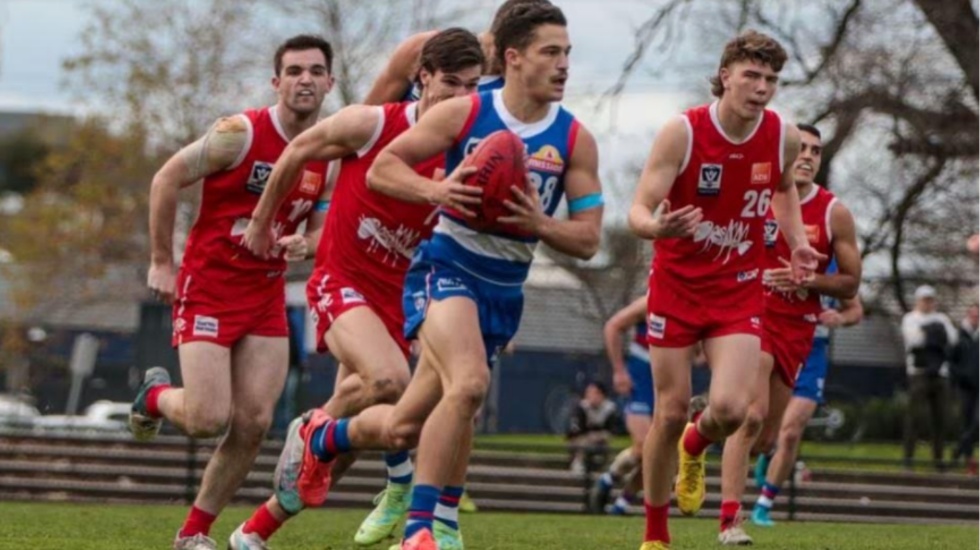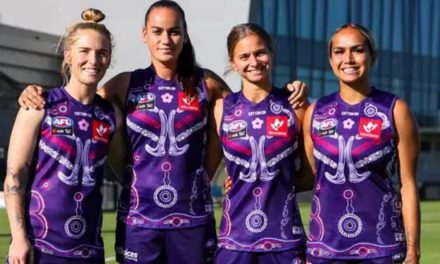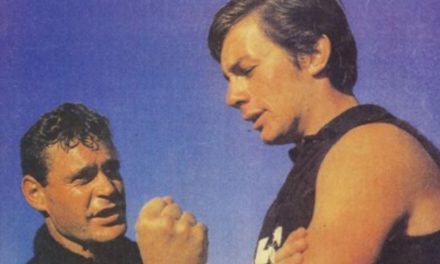Footscray’s Riley Garcia sprints clear during the Bulldogs’ thrashing of the Northern Bullants on the weekend. Photo: AFL MEDIA
Right now, there is a rather large elephant in the AFL room. This pachyderm is feeding on a rather unusual diet. It consists of Lions and Bullants, along with a Dolphin most weeks.
Unusual it may be, but it’s not unexpected. The elephant here is, of course, the Victorian Football League. Actually, the VFL these days is perhaps more Frankenstein’s monster than an elephant. It comprises 21 teams from three states, some of which serve as AFL reserves teams, others who stand alone.
Last Saturday, one of those AFL reserves teams – Footscray – defeated the Northern Bullants 24.17 (161) to 0.4 (4). That’s a 157-point thrashing. Such things can happen occasionally, of course. There will always be statistical outliers.
Unfortunately, this was no statistical outlier. A week earlier the Bullants were crushed by 144 points by Werribee. In the game before that they lost to Brisbane’s reserves by 128 points.
Incredibly, the Bullants are not even the bottom side. That ‘honour’ belongs to Coburg, which could not even manage to defeat the Bullants in May. The Lions are winless after 18 VFL rounds in 2023. Meanwhile, Frankston (the Dolphins) have managed three wins.
These three standalone sides occupy three of the bottom four places on the VFL ladder. Among them is the Sydney reserves team, with just two wins. The Swans’ AFL side has been decimated by injury, however, leaving its VFL side extremely vulnerable.
Last year the Swans were a top-four VFL side, but Frankston and Coburg were in the bottom five. In the two completed seasons before COVID hit, the Dolphins and Lions occupied the two bottom places on the ladder.
The AFL’s top tier has measures in place to ensure – in theory at least – that clubs cycle up and down the ladder. The VFL has no such mechanism.
For the good of footy, and especially the standalone VFL clubs – not all of which are struggling it must be said (Werribee and Williamstown are currently second and seventh on the ladder) – a circuit breaker is surely required.
But who will provide that circuit breaker? Surely this is an issue the AFL should be examining closely. It might not require direct intervention from incoming CEO Andrew Dillon but he should at least be making sure someone within the organisation is addressing the matter.
An often-overlooked fact is that the AFL is the custodian of the game. My impression from the outside is that the AFL itself often overlooks this fact.
PLEASE HELP US CONTINUE TO THRIVE BY BECOMING AN OFFICIAL FOOTYOLOGY PATRON. JUST CLICK THIS LINK.
The AFL has a charter, introduced in 2014, that provides guidance to the Laws of the Game committee, but it does not appear to have an equivalent charter providing guidance to the state leagues.
Perhaps in the case of the VFL, that falls to AFL Victoria. However, a quick look at the ‘Role of AFL Vic’ page on AFL Victoria’s website does not even mention the VFL.
I don’t have the solution to the increasing inequity of the VFL competition, but someone surely should.
Is the AFL hoping the standalone sides will quietly disappear? Or is it considering going ‘back to the future’ by reinstating a full reserves competition, leaving the other clubs to fend for themselves?
From the AFL teams’ perspective, this would make sense. The AFL’s reserves sides play only 18 games a season, five fewer than the senior sides, which presents frustration to both coaches and non-selected AFL players alike.
The latter option would echo the events of 1896, when eight of the 13 VFA sides broke away to form the VFL. There was an expectation that the remaining five clubs might fold. Instead those clubs redoubled their efforts, added Brunswick to the Association and began to thrive alongside the VFL.
Three of those five clubs eventually joined the VFL. The other two, Port Melbourne and Williamstown, went on to dominate the VFA. Port won a VFL flag in 2017 and Williamstown came within a whisker of doing so in 2019, but one senses another premiership for either side remains a long way off.
For sides like the Northern Bullants, Coburg and Frankston, even the word ‘finals’ would rarely be used. These three clubs were founded more than 130 years ago (the Northern Bullants as Preston). They deserve a more certain future, whatever form that may take.
The dilemma of how to deal with this issue may once have fallen under the remit of the Australian National Football Council. The ANFC was the national governing body for Australian rules football in Australia from 1906 until 1995. It handpassed the role to the AFL Commission in 1996.
One gets the impression the AFL Commission has been focused on other, more commercial, aspects of the game since then.
Until someone steps up to address the VFL dilemma, Bullants, Lions and Dolphins will continue to be fodder for the elephant in the AFL room.












This is not just a VFL issue, it is a country wide issue. You need a good, strong/robust viable 2nd tier competition throughout the country to develop the next generation of AFL talent. We don’t have the college system like America does, where all the development takes place. Victoria has been the premier football state since the game began but they won’t even play State footy against SA & WA anymore because they’re no longer competitive. Unfortunately the state leagues are all struggling and run on the smell of an oily rag. It’s gets even worse at amateur level, the standard is poor across the board. The AFL is too big, it should be the tip of the iceberg buts in fact it’s the inverse. The AFL is slowing eating its own. In WA you just have to have a look at the merging of junior councils so they can run competitions, especially amongst the yr 11/12’s. Too much emphasis on the next 18yr old and, unfortunately, there are just too many teams in Melbourne vying for too few resources.